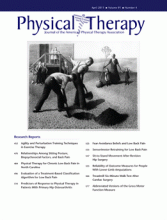Abstract
Background Few studies have investigated or identified common clinical tests and measures as being associated with progression of hip osteoarthritis (OA); fewer still are longitudinal studies exploring prognostic variables associated with long-term outcome following physical therapy treatment.
Objective The purpose of this study was to determine a set of prognostic factors that maximize the accuracy of identifying patients with hip osteoarthritis (OA) likely to demonstrate a favorable response to physical therapy intervention.
Design This was a prognostic study.
Methods Ninety-one patients with a clinical diagnosis of hip OA were analyzed to determine which clinical measures, when clustered together, were most predictive of a favorable response to physical therapy intervention. Responders were determined based on OMERACT-OARSI response criteria, which included percent and absolute changes in pain, function, and global rating of change over 1 year. These data served as the reference standard for determining the predictive validity of baseline clinical examination variables. Using multivariate regression analyses and calculations for sensitivity, specificity, and positive and negative likelihood ratios, a cluster was identified.
Results Five baseline variables (unilateral hip pain, age of ≤58 years, pain of ≥6/10 on a numeric pain rating scale, 40-m self-paced walk test time of ≤25.9 seconds, and duration of symptoms of ≤1 year) were retained in the final model. Failure to exhibit a condition of 1 of the 5 predictor variables decreased the posttest probability of responding favorably to physical therapy intervention from 32% to <1% (negative likelihood ratio=0.00, 95% confidence interval=0.00–0.70). Having at least 2 out of 5 predictor variables at baseline increased the posttest probability of success with physical therapy intervention from 32% to 65% (positive likelihood ratio=3.99, 95% confidence interval=2.66–4.48), and having 3 or more of 5 predictor variables increased the posttest probability of success to 99% or higher. A comparison with a control group that did not receive physical therapy further substantiated the cluster.
Limitations The small sample size and the number of variables entered into the logistic regression model may have resulted in spurious findings. This study must be validated in replication studies before it can be considered for use in clinical practice.
Conclusions This study completed the first step in the development of a preliminary cluster of baseline variables that identify patients with hip OA as positive responders to physical therapy intervention.
Footnotes
All authors provided concept/idea/research design and writing. Dr Wright provided data collection. Dr Wright and Dr Cook provided data analysis. Dr Baxter and Dr Abbott provided fund procurement and institutional liaisons. Dr Wright, Dr Cook, Dr Flynn, and Dr Baxter provided consultation (including review of manuscript before submission). The authors thank the Management of Arthritis (MOA) trial team for providing treatment protocols.
The study was granted ethical approval by the Lower South Regional Ethics Committee of the New Zealand Ministry of Health.
This research was supported, in part, by a contract from the Health Research Council of New Zealand and the New Zealand Lottery Health Board. Dr Wright, Dr Abbott, and Dr Baxter were supported, in part, by the Health Research Council of New Zealand and by the Centre for Physiotherapy Research, University of Otago. Dr Wright also was supported, in part, by a University of Otago postgraduate publishing bursary.
Data used for the purposes of this study were part of a larger randomized controlled trial (Australian New Zealand Clinical Trials Registry: ACTRN12608000130369).
- Received May 16, 2010.
- Accepted November 22, 2010.












